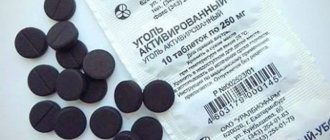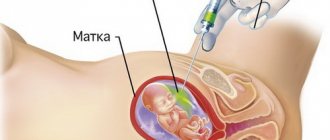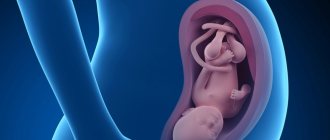The main purpose of Motilium is to establish a stable digestive process. The drug allows you to eliminate such unpleasant symptoms as heaviness after eating, nausea, increased gas formation, bloating and constipation. The main components of the product have a gentle effect on the muscular system of the stomach, causing it to actively digest food and remove waste products naturally. Next, we will take a closer look at how to properly take Motilium during pregnancy.
Composition and release form
The antiemetic drug Motilium is produced in several forms, each of which can be prescribed during pregnancy:
- Pills. Convex on both sides, they have the inscriptions “M/10” and “JANSSEN” on different parts. Made in white or light cream color, covered with a film shell. Packaged in blisters, sold in 10 and 30 pieces per package.
- Suspension. The liquid preparation is available in dark brown glass bottles (100 ml) and is accompanied by a dosage syringe. The consistency of the medicine resembles jelly.
- Lozenges. They are fragile, available in white and do not require drinking. When interacting with saliva, they turn into mush. Sold in cardboard boxes of 10 or 30 pieces.
The active ingredient in Motilium is domperidone. In addition to it, the composition may contain components such as:
- poloxamer 188, mannitol, aspartame, gelatin, mint essence in lozenges;
- potato and corn starch, lauryl sulfate, lactose, magnesium stearate to create a shell;
- sodium hydroxide, microcrystalline cellulose, polysorbate, propyl and methylhydroxobenzoate.
During pregnancy, you can use any form of the drug, but before doing so, it is better to consult a specialist about the dosage and frequency of use.
About the drug
Motilium is an over-the-counter antiemetic drug that is a central blocker of dopamine receptors. The action of Motilium is:
- normalization of the process of food movement, by influencing the muscles of the gastrointestinal tract;
- suppression of receptors responsible for the feeling of nausea;
- eliminating symptoms of indigestion.
A particularly fast-acting form of the drug is lozenges. They use Zydis technology, which makes them dissolve 50 times faster than regular tablets. The drug is produced in Belgium.
Release form
The dosage form of Motilium is represented by lozenges, film-coated tablets and suspension.
- Lozenges (10 mg) are white and packed in a blister made of polyvinyl chloride or aluminum, 10 pieces each. 1 or 3 blisters are placed in a cardboard box along with instructions.
- Film-coated tablets (10 mg) have a round, biconvex shape and are white in color. On one side of the tablet there is the inscription "JANSSEN", and on the other - M/10. They are packaged in PVC or aluminum blister packs of 10 or 30 pieces. 1 blister is placed in a branded box with instructions for use.
- The suspension (1 mg/ml) has a uniform structure and white color. The liquid is contained in a 100 ml bottle made of tinted glass with a lid that is protected against accidental opening. The bottle, instructions and dosing syringe are placed in a cardboard box.
Compound
Lozenges contain 10 mg of domperidone. Excipients:
- mannitol;
- gelatin;
- aspartame;
- poloxamer – 188;
- mint essence.
Coated tablets contain domperidone - 10 mg. Auxiliary components:
- pregelatinized starch;
- lactose monohydrate;
- microcrystalline cellulose;
- corn starch;
- magnesium stearate;
- sodium lauryl sulfate;
- povidone-K90;
- Hydrogenated cottonseed oil.
A suspension of 1 ml contains 1 mg of domperidone. Auxiliary components:
- carmellose sodium;
- liquid sorbitol, non-crystallized 70%;
- microcrystalline cellulose;
- propyl parahydroxybenzoate;
- polysorbate;
- sodium saccharinate;
- methyl parahydroxybenzoate;
- sodium hydroxide, water.
Indications for use
In pregnant women, Motilium is used for the following ailments:
- heartburn;
- nausea and vomiting due to toxicosis;
- stomach ache;
- food poisoning;
- flatulence;
- aggravated stomach ulcer.
Mechanism of action
Domperidone, the active substance of Motilium, blocks dopamine receptors, as a result of which nerve impulses from the gastrointestinal tract cease to be conducted to the vomiting center. When ingested, the drug is absorbed in the intestine and accelerates the contraction of the stomach walls, improves the tone of the lower esophageal sphincter, and activates peristalsis.
It fights constipation, which often occurs during pregnancy: the active substance provokes increased production of bile by the liver and promotes its release by the gallbladder.
After taking it, gas formation decreases, the feeling of heaviness and bloating disappears.
Due to its ability to increase prolactin levels in the blood, Motilium can be used to stimulate lactation in nursing women. In this case, the dosage of the drug should be minimal, since domperidone is absorbed into the body and passed on to the baby along with breast milk.
Treatment of toxicosis during pregnancy
If you count, toxicosis lasts the first three months. For many, it attacks more in the morning, but is more common in the evening before bed. In the presence of chronic diseases of the liver and biliary tract, it manifests itself more seriously. To block severe vomiting and nausea, it is first important to correct the situation with these organs.
Drugs such as Gepabene, Hofitol, etc. are recommended.
They help the liver adapt to the new state of the body and relieve general symptoms. To avoid dehydration, you need to add hydrolysates. If the nausea is very severe, then in consultation with the doctor, Motilium or its analogues are prescribed. Among homeopathic remedies, let's say Sepia, Ignatia, etc.
In addition, the specialist must explain how to get rid of toxicosis in severe cases in the presence of kidney pathology. Diuretics, special diet and supportive care are indicated. Usually, it is outpatient with regular monitoring of urine and blood tests. Situations with severe loss of body weight pose a danger. Inpatient treatment must be provided here. There is a risk of third degree toxicosis, when any movements cause nausea and symptoms of general weakness are noted against the background of a low-grade fever of 37 degrees.
Features of use during pregnancy
Before prescribing Motilium to a pregnant woman, the doctor must find out how far along the pregnant woman is in order to adjust the dosage and frequency of taking the medication indicated in the instructions.
First trimester
At the beginning of pregnancy, Motilium is prescribed to relieve toxicosis - nausea and vomiting. However, the drug is used only if the benefits for the woman outweigh the negative effects on the fetus, because there is not enough research on the effects of domperidone on the child.
When using the antiemetic drug Motilium in the early stages of pregnancy, you need to constantly monitor your health. It must be taken with strict adherence to the instructions in the instructions: 1 tablet (10 mg) 4 times a day for nausea, heartburn and 2 tablets 3-4 times a day for vomiting. The breaks between doses should be equal.
It is better to use the product 15–30 minutes before meals, so that the active substance is quickly absorbed into the intestinal walls. When taking the medicine after meals, the period of action increases due to a decrease in acidity in the stomach.
The course of treatment is a month. If during this time the unpleasant symptoms do not go away, you should consult a therapist or gynecologist.
Second and third trimesters
In the later stages of pregnancy, treatment with Motilium is adjusted by a doctor. The doctor must take into account the developmental characteristics of the fetus and the health of the mother, since the effect of domperidone on the child has not been studied.
If there are no prohibitions, the drug is taken according to the instructions: 1 tablet 3-4 times a day for dyspeptic symptoms and 2 tablets 3-4 times a day for gastrointestinal disorders.
You need to take the medicine 15–30 minutes before meals so that the substance is absorbed smoothly.
The treatment period for pregnant women is one month. If your health does not improve, you should consult your doctor about changing your medication.
How to use?
There is no separate regimen for taking Motilium for pregnant women, so you should stick to the “adult” regimen.
- Lozenges should be taken before meals, held in the mouth until completely dissolved, and then swallowed. The drug dissolves within 2-3 seconds and does not require drinking with water. Take 2-3 tablets 3-4 times a day.
- The coated tablets should be taken whole before meals and washed down with water. Use 1-2 pcs. 3-4 times a day.
- The suspension should be taken 10-20 ml 3-4 times a day. The maximum daily dose is 80 mg. Duration of treatment is up to 28 days. If kidney function is impaired, the dose of any dosage form is reduced to 1-2 times a day.
Contraindications and side effects
When taking Motilium during pregnancy, you should carefully study the list of prohibitions on using the medicine:
- diagnosed bleeding from the gastrointestinal tract;
- intestinal obstruction;
- diseases in which it is prohibited to accelerate peristalsis;
- body weight less than 35 kg;
- moderate to severe liver failure;
- individual intolerance to the components of the drug.
Side effects from domperidone include:
- gynecomastia and increased prolactin levels;
- temporary nausea and increased vomiting;
- cramps in the intestines;
- itching, rash, urticaria, shortness of breath.
If these symptoms occur in pregnant women, you should consult a doctor, who will advise you to discontinue the drug or reduce its dosage.
The instructions indicate that due to the use of Motilium, a child sometimes develops a weight deficiency.
Side effects
Based on pharmacological studies and real reviews of Motilium, the instructions for use list a number of possible side effects. The probable frequency of occurrence of these most adverse human conditions is also indicated. Among them, dry mouth is the most common. This symptom is reported by 1 to 10 percent of people taking the drug.
Quite rarely, body conditions such as diarrhea, decreased libido, anxiety, sleep disturbances, headaches, rashes, itching or irritation on the skin, increased fatigue, increased production of breast milk and increased sensitivity of the breast, leading to pain in the mammary gland, may occur. .
Also, side effects may include urticaria, Quincke's edema (as a manifestation of an allergic reaction to the components of the drug), increased excitability and nervousness, convulsions and hyperkinesis, tics, increased production of the hormone prolactin, leading to gynecomastia (enlarged mammary glands in males) or stopping the menstrual cycle in women, problems with urination, arrhythmia or disorders of the liver and kidneys.
Drug interactions
During pregnancy, it is not recommended to combine Motilium with anticholinergics.
When combining the drug with Cimetidine, baking soda, antacids and antisecretory agents, the absorption of domperidone in the body is reduced.
There is an increase in the concentration of the active substance in the blood plasma when taking the drug simultaneously with azoles, macrolides and antiretroviral therapy.
Motilium can be used with Bromocriptine, Levodopa, Digoxin, Paracetamol and antipsychotic substances, the effect of which is not enhanced by domperidone.
Diagnosis of toxicosis during pregnancy
Toxicosis in the first trimester is quite common and may be the first sign of an interesting situation. But cases are different. The doctor definitely recommends:
- Analysis of urine. It can detect protein in case of kidney problems, as well as acetone in difficult cases;
- general blood analysis;
- blood sugar test due to the risk of developing gestational diabetes and problems with insulin absorption.
Toxicosis during pregnancy provokes pressure surges.
For most, the pulse increases to and can reach about 100 beats per minute. In critical situations - 120 blows and provoke a state of general intoxication. The doctor is obliged to monitor blood pressure regularly and be sure to explain to the pregnant woman how to do this at home if she has a tonometer.
Analogs
During pregnancy, in addition to Motilium, you can use products with similar effects.
Table - What can replace the drug
| Analogue name | Active substance | Dosage (according to instructions) | Differences from Motilium |
| Damelium | Domperidone |
| Available only in tablet form |
| Passazhiks | Available in chewable tablet form | ||
| Motinorm | Presented in tablet form | ||
| Domstal-O |
|
| Used to treat peptic ulcers; |
The effect of drugs on women during pregnancy has not been fully studied, so only a doctor can prescribe treatment.
Dosage and application regimen
"Motilium" during pregnancy, as in other conditions, has a specific dosage regimen and method of application. It is better to take it before meals, since after eating the absorption of the active substance worsens.
For adults and children who are over 12 years old and whose body weight is more than 35 kg, it is recommended to take 4 tablets of 10 mg per day. That is, the daily dose of the drug is 40 mg. 3 tablets should be taken during the day and 1 before bed.
Initially, the drug is taken for a month. After this period, you need to reassess your condition and, if necessary, conduct an examination. The doctor will either recommend continuing to take Motilium or cancel it, possibly replacing it with another drug.
It is important to draw your attention to the fact that the duration of taking the drug without a doctor’s prescription should not exceed two weeks. If you suddenly miss the time of taking the medication, then you should not take a double dose the next time you take it. It is enough just to continue taking the pills according to the established scheme.
It is not recommended to give the drug in tablet form to children under 12 years of age. Motilium suspension is provided especially for the treatment of pediatric patients. It must be given to the child strictly at the same time. The amount of the drug given at one time depends on the condition of the child and his body weight. These nuances are specified in the instructions for use.
For acid reflux (commonly known as heartburn), the medicine should be taken half an hour before meals. It is also important to strictly follow the prescribed dosage. A special measuring pipette or syringe is provided for this.
Reviews
Experts are skeptical about Motilium and quite rarely prescribe it when carrying a child, since there is insufficient data on the effect of domperidone on the fetus. Motilium is usually recommended when a woman suffers from severe toxicosis, because the benefit to the mother will be much higher than the potential risk to the baby.
Pregnant women respond positively to the medicine: the product helps to partially cope with nausea and vomiting after the first use.
Folk remedies and methods of prevention
During pregnancy, traditional methods of treating nausea and vomiting include:
- sweet and sour tea made from dried fruits;
- rosehip tea 2 times a day;
- 1 tsp. honey in the morning will help relieve nausea;
- drinking freshly squeezed juices from fruits or the fruits themselves in raw form.
Methods for preventing toxicosis and heartburn:
- walk more in the fresh air;
- eat in small portions;
- give preference to protein foods;
- drink mineral water;
- rest after eating.
At the first sign of nausea, you should not grab Motilium. But if you suffer from severe vomiting and toxicosis does not subside, then the doctor will most likely recommend this particular drug, because it has been successfully used for about 40 years.
Pregnancy is not always a joyful event for a woman, since in the first weeks of an exciting state she has to deal with disturbances in the functioning of the gastrointestinal tract. First of all, hormonal changes in the body affect the functioning of the stomach - a woman constantly feels sick or only in the morning. In subsequent months, you have to deal with constipation due to weak intestinal motility. In both cases and throughout the entire period, Motilium will help during pregnancy, the specifics of its use will be discussed below.
When should you not take the drug?
The drug has some contraindications for use. The main one is bleeding, which occurs in both the stomach and intestines. There can be many reasons for this phenomenon. These include ulcerative lesions, as well as erosions, polyps and tumors. For these pathologies, the drug is not used, as it may aggravate the situation. Due to increased motor function, food will move faster through the gastrointestinal tract. In this case, damaged walls of the intestines or stomach can provoke even more bleeding.
It is dangerous to take the medicine if there is perforation or obstruction of the gastrointestinal tract. The rapid passage of food through the stomach can cause painful shock, peritonitis and other serious side effects.
This medication is contraindicated in the presence of a pituitary tumor, which is caused by hypersecretion of prolactin. The fact is that the drug is able to enhance the production of this hormone, which will accelerate the growth of formation and aggravate the course of the disease. The same remark applies to other pathologies that depend on excessive secretion of prolactin. This may be hyperprolactinemia, as well as fibrocystic mastopathy. The use of domperidone will provoke an even greater expansion of the milk ducts, which will increase swelling and pain in the mammary glands.
eXzJKhHi2y8
Motilium or Motilak - which is better?
Domperidone is found in many drugs, such as Motilium, Motinorm, Motilak and others. Having carefully studied the descriptions of these drugs, it is not difficult to understand what the difference between them is. Motilium is the original (branded) drug, and Motilak is its generic. Patients and doctors have broken many lines in disputes about which product is better - branded or generic? The original drug is believed to be more effective in most cases, but it almost always costs more than the generic drug. In addition, Motilak is available only in the form of lozenges, which means it is not suitable for small children.
Uncontrolled drug use is one of the huge problems of modern society. In conditions where every patient is his own doctor, when medications can be freely purchased at a pharmacy, the development of serious complications from taking medications has long been no surprise to workers in medical institutions.
One such drug that most people consider “harmless” is Motilium. In fact, this drug has quite dangerous side effects that can be life-threatening for the patient.
While carrying a baby, and especially in the first months, a woman’s body undergoes enormous changes in its usual working mechanisms. The result of such changes is often toxicosis with its inherent nausea or even vomiting. If unpleasant manifestations of an “interesting situation” make themselves felt from time to time, a woman can endure these periods. However, there are times when a constant feeling of nausea literally torments a woman. The pregnant woman loses her appetite, her weight decreases, and her general health only worsens. Such situations cannot be left to chance. A drug such as Motilium exhibits a good antiemetic effect. Is it safe to take it while expecting a baby?
Motilium is a drug that not only reduces the number and intensity of vomiting, but also stimulates the functioning of the gastrointestinal tract. What drug compounds provided these effects?
Composition and release form of Motilium
The active compound in Motilium that forms its therapeutic effect is domperidone. This substance blocks dopamine receptors, providing an antiemetic effect, as well as stimulating intestinal motility.
The drug is available in the form of tablets and suspension.
- 1 round, biconvex film-coated pill contains 10 mg of active substance. Additional components include lactose (pay attention if you are intolerant to this compound!), corn and potato starch, cottonseed oil, sodium lauryl sulfate, povidone, magnesium stearate and cellulose. The package contains 1 or 3 blisters, which corresponds to 10 or 30 tablets.
- The concentration of domperidone in suspension is 1 mg per 1 ml of medication. Auxiliary compounds are sorbitol, cellulose, sodium hydroxide, sodium saccharinate, methyl parahydroxybenzoate. This form is more widespread among children, but it can also be used to treat adults. The medicine has a sweetish taste.
Pharmacological action of Motilium
- As a result of oral administration, the components of Motilium are quickly absorbed by the gastrointestinal mucosa, stimulating active contraction of the walls of the upper parts of the digestive system - the esophagus, stomach, duodenum. Food moves better through the sections of the digestive tract, without stagnating in its individual sections. Normalizing gastrointestinal motility helps get rid of the feeling of heaviness in the stomach and bloating.
- Domperidone also stimulates the release of bile from the bladder of the same name, preventing its stagnation. This fact also has a positive effect on the motor function of the gastrointestinal tract and the digestive process in general.
- The active compound also affects dopamine receptors in neuronal cells. The result of this effect is a decrease in nausea and a decrease in the intensity of vomiting.
- The active compound of the drug affects the production of prolactictin (increases synthesis), necessary for the production of breast milk.
Indications for use of Motilium during pregnancy
Based on the action of the active compound of the drug - the active evacuation of food into the duodenum - a list of indications for the use of Motilium is determined. In what cases can the medicine be prescribed?
- Toxicosis in the first or last months of pregnancy, accompanied by nausea or vomiting.
- Heartburn. This condition can be either physiological, provoked by pregnancy itself, or a manifestation of reflux disease (associated with insufficiency of the sphincter separating the esophagus and stomach).
- Nausea and vomiting caused by infectious diseases.
- Disorders of the motility of the digestive organs and its manifestations - bloating, flatulence, a feeling of heaviness and discomfort in the stomach.
- Indigestion (dyspepsia) of various origins, diarrhea.
During the period of bearing a baby, Motilium is not prohibited, but the use of the drug must be agreed with doctors.
Motilium dosage
Since the medicine is prescribed by a doctor, the dosage, frequency of administration and duration of therapy are also determined by the doctor. What is indicated in this regard in the annotation for the drug?
- It is better to take Motilium before meals. In this case, the absorption of its active compound will be better. In case of nausea, take the drug 2 hours before meals. If a woman is bothered by heartburn, the interval between taking the medicine and eating should be about 30 minutes.
- The dosage of the drug must be followed exactly. If a woman has chosen the medicine in syrup form, she must use the measuring pipette included with the medicine.
- The duration of treatment is determined by the doctor, but it should not exceed 7 days.
- If you miss a dose of medication, you should not take a double dose. Take the tablets as prescribed.
- The maximum daily dosage of Motilium is 30 mg, divided into 3 doses.
Contraindications to taking Motilium during pregnancy
Like any medicine, Motilium has a number of restrictions on its use.
These include:
- Deviations in the functioning of the liver and/or kidneys.
- Disturbances in cardiac activity.
- Bleeding in the gastrointestinal tract.
- Intestinal obstruction.
As for the period of gestation, Motilium does not have a strict ban on the use of the drug. Currently, there is no data regarding the effect of domperidone on the formation of malformations in children during intrauterine development. Caution in prescribing Motilium is associated with a small number of examinations of women undergoing therapy with domperidone.
Among the side effects of the drug's activity are:
- Diarrhea.
- Anxiety, sleep disturbance.
- Headache.
- Allergic manifestations in the form of skin rash, itching or areas of irritation.
- Increased fatigue.
- Increased breast sensitivity.
Causes of toxicosis
Despite the modern development of medicine, the exact cause of early toxicosis has not yet been established. But predisposing factors are divided into several groups:
- Immune response. Before the placenta is formed, the immune system perceives male protein as a foreign, dangerous element.
- An increase in the level of the hCG hormone affects some parts of the subcortex of the brain, which causes increased salivation and nausea.
- Physiological changes in the female body during the first pregnancy after 35 years.
- Hereditary predisposition.
- Severe chronic or untreated diseases.
- Stress, nervous tension during pregnancy.
- Multiple pregnancy.
- Alcohol abuse, fast food, unhealthy diet, smoking during pregnancy planning or conception.
- Psychological reason, including fear for the future of the child, possible problems after childbirth and as the baby grows up, financial issues, fear for changed body shapes, stretch marks, excess weight, problems associated with unsuccessful previous births or negative experiences of friends, relatives, change lifestyle, relationship with the child’s father.
Indications for treatment
The decision about drug treatment with tablets for early toxicosis during pregnancy should be made only by a doctor. You cannot self-medicate. This can harm the child and the mother herself. Drug therapy becomes advisable at stages 2 and 3 of toxicosis, when the pregnant woman suffers from profuse vomiting, loses weight, and cannot eat properly.
A signal to see a doctor should be vomiting, which increases in frequency up to 10-20 times, deterioration in health due to a decrease in the amount of urine excreted per day and the smell of acetone from the mouth. A decrease in the daily amount of urine to a liter is a direct indication for hospitalization and taking medications (drugs that mitigate toxicosis and support the body’s strength).
To eliminate signs of toxicosis, doctors prescribe medications that cannot harm the baby. Cerucal is often prescribed to dull vomiting. The peculiarity of the medicine is in the list of side effects and the inability to use it in the first trimester. A medication that actively acts on the central nervous system can be used only after the formation of the embryo in the 2nd and 3rd trimesters under the supervision of a doctor.
To remove toxins in early toxicosis and late gestosis, “Hofitol” is used, a safe herbal preparation. To reduce the frequency of vomiting, doctors may also prescribe:
- "Metoclopramide" - activates the passage of food through the esophagus and stomach.
- Zofran is the safest proven anti-vomiting remedy and is used as an alternative to Cerucal, including in the first trimester.
Drugs to relieve toxicosis
Intoxication of the 2nd degree is treated on an outpatient basis under the supervision of a physician. In addition to vitamins, a woman receives hepatoprotectors, hofitol, and essentiale per day. Toxicosis of the 3rd degree is treated in a hospital, where the woman is prescribed infusion therapy with intravenous drips, and sedatives are added to the above medications.
About risks
Remember that medications taken without medical supervision, and especially their overdose, can cripple and even kill mother and child. It is especially dangerous to experiment at the initial stage of pregnancy, when the formation of the baby’s main organs and systems occurs.
Considering the high degree of risk, if the manifestations of toxicosis are tolerable and not dangerous, try to improve the condition in a natural way. This will help:
- proper nutrition in small portions;
- a menu based on fresh fruits, vegetables, lean meat, always at a comfortable temperature;
- complete rest;
- regular walks;
- positive emotions.
You can overcome morning nausea by simply sucking on a rye cracker or a slice of lemon.










